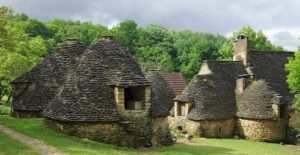Cabanes du Breuil, a small hamlet of round dry stone buildings with corbelled vaulted ceilings covered with lauze tiles.
Midway between Sarlat and Les Eyzies, they are reached along a winding road off the D47 which is a lovely drive through mixed deciduous woodland. Thinking this is rather an esoteric site, I thought it might be quiet until I saw the road sign for coaches… We were there early and by the time it opened there were three other cars and a camper van waiting. During the visit, there was a steady stream of people through.
It is a lovely setting among the trees above the Vereze valley. Ducks, geese and hens were running around with their young. There were turkeys, peacock and an old dog. A construction site with two half built cabanes explains how they were built. There is also a ‘build your own cabane’ corner.
The date of the buildings isn’t known but there are records from 1449 when they belonged to the Benedictines of Sarlat. They were lived in until the 15thC when they fell into disuse. In the 18th/19thC artisans began to settle the area and three of the cabanes were restored and lived in by a cooper, weaver and a blacksmith. This is the only reason this site survives.
The buildings have dry stone walls with a beautifully corbelled ceiling inside. The walls were often about 1m thick at the base but taper towards the top. The outside of the roof is covered with lauze tiles with a single stone slab on the top. This was the last stone to be put into place using a wooden ladder. Larger buildings used for living in have a small dormer window in the roof. Stone was quarried locally. The top 40-70cm provided weathered stone for the lauze tiles. The lower layers were used for walls and corbelled ceilings. The quarries were rarely more than 1m deep.
Entering the site, the building facing is the cooper’s hut. This was being used to house goslings when we visited. Opposite are three cabanes joined together to form a single building with an oven at one end. The door is set high on the wall and reached by flat stones protruding from the walls.
Beyond it is the weaver’s hut. This originally had animals living on the ground floor with the family living above on a wooden balcony. The fireplace was added in 1988 and the house is now used to display old utensils and tools. It is very dark with little room inside.
Behind is a reconstructed shepherd or vineyard hut. These were typical of the Perigord area and were used as shelter for men or implements. The walls were not as thick as the typical cabanes and there is no layer of lauze tiles on the roof. They have a low doorway but no windows. Most are now disused and only survive on the edges of previously cultivated land.
There are also a couple of brushwood huts. Heather was gathered in the winter and dried for about a month before being used to cover an A frame. This can last for 30 years and huts were mainly used for storage.
There is a lot of old farm machinery scattered around the site, most unidentified.
The cabanes are part of a working farm with the owners living in a farmhouse which adjoins the three joined cabanes. The back north wall and roof are a typical cabane construction with no windows. The south facing wall has been modernised.
We felt the site had been opened as a form of diversification to increase farm income. There is a video (French only) in a newly built hut covering the history of the site. We were given a booklet in English to be returned as we left. This had information about the cabanes. These are numbered but there was no plan in the book. We never did find the cooper’s hut. Soft drinks, tea and coffee are sold at the ticket office which sells post cards and shopping bags. There are no toilets. It isn’t your usual slick tourist attraction, and does feel a bit amateurish. This is part of its charm.
We enjoyed our visit and found it a fascinating place – but we are intrigued by buildings like these. They are very photogenic. It may not be to everyone’s taste!








